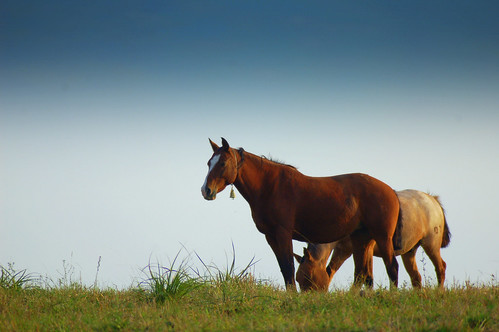Jennifer L. Stevens
Cornell Cooperative Extension Saratoga County
As an extension agent, I often get phone calls about horses that are sick and suspected to have a contagious disease. Before causing unnecessary alarm in your barn or damaging rumors within your community, it is advisable to follow the steps below.

![]() Photo Credit: Eduardo Amorim via Compfight
Photo Credit: Eduardo Amorim via Compfight
As a general rule, it is always best to call your veterinarian if you notice something is different or “off” with your horse. However, if you suspect that it is a highly contagious disease, here are some immediate steps you should take:
- CALL YOUR VETERINARIAN!
(a) Take your horse’s vitals if possible and have them ready to give to the vet. - Separate the horse from the rest of the herd immediately
- Wash your hands with hot water and soap
- Remove all items of clothing that have come in contact with the sick horse and launder them well.
- Use plastic boot covers over your boots and discard after use to avoid spreading the disease from stall to stall or pasture to pasture. If you do not have boot covers, prepare a diluted “bleach bath” in a tub large enough to stand in, and make sure you thoroughly clean your boots.
- Use separate equipment (water buckets/feed scoops/pitchforks/wheelbarrows/etc.) for feeding, stall cleaning, hay and manure removal. Do not place shavings, manure, or partially eaten hay that may have come in contact with the sick horse in an area accessible to other horses.
According to the New York State Department of Agriculture and Markets, equine diseases listed as “reportable” are subject to Animal Disease Reporting requirements. The laws of the State of New York (Ag & Mkts Law, Article 5, §73) require that “every person shall immediately report to the commissioner the existence among animals of any infectious or communicable disease coming to his knowledge. Every report shall be in writing and shall include a description of the diseased animal or animals, the location thereof, the name of the disease suspected, and, if known, the name and address of the owner or person in charge of such animal or animals.”
In practical terms, not every disease or disease occurrence is of equal importance and the reporting of every occurrence of every disease would overwhelm surveillance for those diseases of greater importance because of their potential impact on animal health, public health, or the economic viability of the agricultural industry in the state and the nation.
Animal Disease Reporting can be divided into two categories. The first is when the occurrence of disease is recognized but the specific disease or agent is unknown. The second is when a specific Reportable Disease has been identified, usually through laboratory confirmation/identification of a specific disease agent or toxin. This includes any of the diseases on the CDC list of Select Agents, the USDA list of High Consequence Livestock Diseases and the USDA list of Foreign Animal Diseases (FAD’s).
Reporting Criteria
In general terms, disease occurrence should be reported either if the disease is identified as one of the specific Reportable Diseases or if any of the following apply:
- The disease presents as a new set of symptoms not previously recognized in the species of animal affected
- The same disease symptoms appear to be affecting animals in multiple locations
- A disease with a recognized seasonal or species distribution occurs in an unusual season or species
- High Morbidity (number affected/unit of time)
- High Mortality (number dying/unit of time)
- Central Nervous System disorders
- Vesicular disease in ruminants or horses
- Hemorrhagic disease
Any individual may report a disease outbreak or suspicious disease occurrence in animals by calling the Division of Animal Industry at (518) 457-3502.
For a list of reportable diseases please visit http://www.agriculture.ny.gov/AI/disease_rep.html or contact the NYS Department of Ag. & Markets at (800) 554-4501 for further information.

